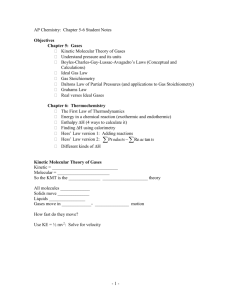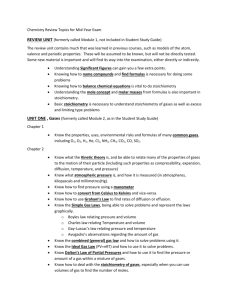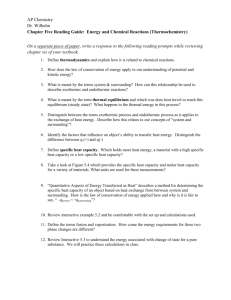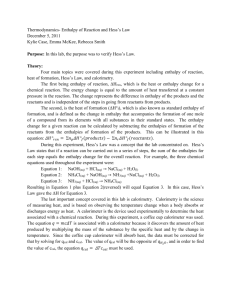Thermo – Gases
advertisement
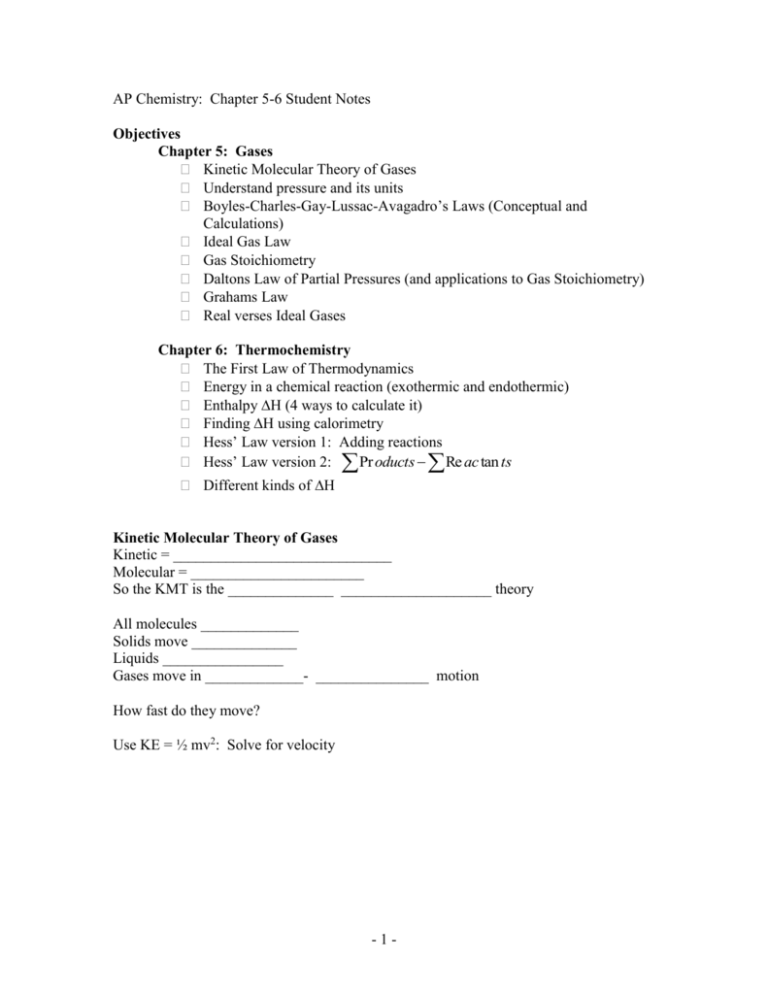
AP Chemistry: Chapter 5-6 Student Notes Objectives Chapter 5: Gases Kinetic Molecular Theory of Gases Understand pressure and its units Boyles-Charles-Gay-Lussac-Avagadro’s Laws (Conceptual and Calculations) Ideal Gas Law Gas Stoichiometry Daltons Law of Partial Pressures (and applications to Gas Stoichiometry) Grahams Law Real verses Ideal Gases Chapter 6: Thermochemistry The First Law of Thermodynamics Energy in a chemical reaction (exothermic and endothermic) Enthalpy ∆H (4 ways to calculate it) Finding ∆H using calorimetry Hess’ Law version 1: Adding reactions Hess’ Law version 2: Pr oducts Re ac tan ts Different kinds of ∆H Kinetic Molecular Theory of Gases Kinetic = _____________________________ Molecular = _______________________ So the KMT is the ______________ ____________________ theory All molecules _____________ Solids move ______________ Liquids ________________ Gases move in _____________- _______________ motion How fast do they move? Use KE = ½ mv2: Solve for velocity -1- Example: Find the velocity of an oxygen molecule in this room Effusion verses Diffusion Effusion = (Draw a picture) Diffusion = (Draw a picture) Grahams Law Conceptual Graham’s Law Equation Example: Calculate the effusion rates of hydrogen gas and uranium hexafluoride. -2- The Meaning of Temperature: Temperatue is the ___________ ___________ _______________ of a molecule in a sample. KE = 3/2 RT Understand Pressure and it’s units Pressure is caused by ____________________ Pressure is measured with a __________________ Toricellian Barometer -3- Units of Pressure 1.0 atm = 760 mmHg = 760 torr = 101.32 kPa Pressure Conversion Practice Boyle-Charles-Gay Lussac-Avagadro’s Law Pressure verses Volume: Boyles Law Graph and Equation -4- Volume verses Temperature (Charles’ Law) Graph and Equation Pressure verses Temperature: Gay-Lussac Law Graph and Equation Combined Gas Law Equation -5- Gas Law Examples: Wilson at the beach Wilson at the top of Pikes Peak Ideal Gas Law Actually a form of the combined Gas Law Derive Ideal Gas Law -6- Example: “Wilson” is filled with oxygen gas. He has a volume of 3.25 L and is at 22C and 0.75atm. How many grams of oxygen are in “Wilson’s” head? Gas Stoichiometry Rules: 1. Balanced Equation 2. Label what you know and what you don’t know 3. Use PV=nRT to solve for either volume or moles of the gas in the equation. 4. Use dimensional analysis to determine answer 5. Step 3 and 4 are sometimes flipped. Example 1 Gas Stoichiometry: Solid potassium chlorate (KClO3) decomposes to produce solid potassium chloride and oxygen gas. What volume of oxygen gas, measured at 40°C and 655 mmHg, will be produced when 13.5 g of potassium chlorate is decomposed? -7- Example 2: Gas Stoichiometry When the following reaction occurs: P(s) + O2(g) P2O5(s) How many grams of P2O5 is produced when 82.54 mL of oxygen at 6000 K and 45 atm is completely consumed? Daltons Law of Partial Pressures The total pressure is equal to the sum of the partial pressures Equation Application (Collecting a gas over water)—Draw Diagram -8- Daltons Law Example 1: When silicon dioxide reacts with carbon by heating, the following reaction occurs: SiO2(s) + 3C(s) SiC(s) + 2CO(g) What will be the volume of carbon monoxide collected over water that will be produced at 22.0˚C and 657mm when 96.25 grams of SiO2 completely reacts? -9- Example 2: A .500 L container contains nitrogen gas at 0.800 atm and 0°C. If the highest pressure the container can withstand before exploding is 3.0 atm, what is the highest temperature to which the gas can be heated? Assume the volume is constant. What is the original temperature in Kelvin? Should T2 be bigger or smaller from the change in pressure? Real verses Ideal Gases No gas is “ideal,” but some are ___________ _______________ Real Gases have 1. ________________________________ 2. ________________________________ Real Gas Equation: 2 n Pobs a x(V nb) nRT V Notice that it is similar to the ideal gas law with two new variables which are constants: see table below. - 10 - Chapter 6: Thermochemistry First Law of Thermodynamics Energy cannot _________________ The sum total of energy in the universe ________________ Thermodynamics means (examine the word) Energy in a Chemical Reaction Energy can flow two ways in a reaction Into: Endothermic Out: Exothermic Called Enthalpy: Symbol is ∆H Four Ways to Calculate ∆H 4 ways to calculate ?H - 11 - Finding ∆H using calorimetry Heat Equation Specific Heat Amount of energy it takes to raise one gram of a pure substance one degree Celsius The lower the specific heat the __________ the temperature change when heated The higher the specific heat the ___________ the temperature change when heated. Units on ∆H Solving for ∆H - 12 - Calorimetry Example 1: Calculating Enthalpy 3.25 grams of Mg is dropped into 125mL of hydrochloric acid. The initial temperature of the calorimeter is 18.5˚C and the final temperature is 25.6˚C. Assume that the heat capacity of the calorimeter is 4.86 J/g˚C. Calculate the enthalpy of the reaction. Calormetry Example 2: Calculating heat capacity A 46.2-g sample of copper is heated to 95.4˚C and then placed into a calorimeter containing 75.0 g water at 19.6˚C. The final temperature of the metal and water is 21.8˚C. Calculate the heat capacity of the copper, assuming that all the heat lost by the copper is gained by the water. - 13 - Hess’ Law version 1: Adding reactions How to find ∆H by adding reactions: All Elements in their standard state have a ∆H equal to _____________ So we can write the formation of several compounds from their elements. This is called the _______________ and is symbolized by __________________ H f : The f stands for _____________ The degree symbol stands for _______________________ Examples heats of formation reactions: - 14 - To find ∆H from reactions you must: 1. Add the “source reactions” such that they cancel out to get the reaction that you are looking for 2. When you multiply a source reaction the value of ∆H for the reaction is multiplied by the same factor 3. when you reverse a reaction the sign of ∆H is switched 4. Sometimes it is easier to multiply the main reaction by a factor and then work the problem. If you do this you must then divide the ∆H of the reaction by that same factor at the end. Examples of finding ∆H using the ADD REACTIONS METHOD Example 1 Calculate the enthalpy for the combustion of C to CO: C(s) + ½ O2(g) CO(g) ∆H=? Using these reactions: C(s) + O2(g) CO2 CO(g) + ½ O2 CO2 (g) ∆H= -393.5 kJ ∆H = -283.0 kJ Example 2 Given the data: N2(g) + O2(g) 2NO(g) 2NO(g) + O2(g) 2NO2(g) 2N2O(g) 2N2(g) + O2(g) ∆H=+180.7 kJ ∆H = -113.1 kJ ∆H -163.2 kJ use Hess’ law to calculate ∆H for the reaction N2O(g) + NO2(g) 3NO(g) - 15 - Hess’ Law version 2: Pr oducts Re ac tan ts This method is the simplest of them all. 1. Underneath the reaction write down the values that you find in the table that starts on page A-21 in the back of your book 2. Add up the products multiplying the values by any coefficients 3. Add up the reactants multiplying any values by the coefficients. 4. Do the calculation: Pr oducts Re ac tan ts Example 1: Finding the ∆H of a reaction using Hess’ Law method 2 Find ∆H for the following reactions: NH3(g) + HCl(g) NH4Cl(s) C3H8(g) + O2(g) CO2(g) + H2O(g) - 16 - Different kinds of ∆H ∆H can sometimes be confusing because there are many different “kinds” of ∆H. This table is a summary of the different kinds of ∆H. H f H fus H vap H solid H cond H sub H comb H sol HCH 4 H rxn - 17 -
